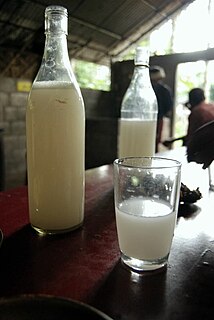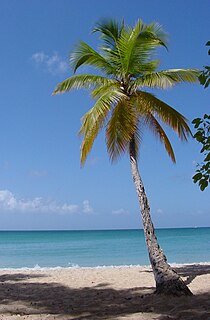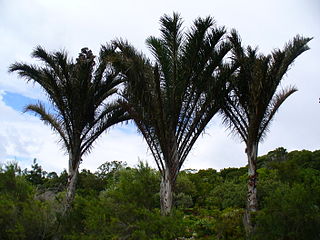| Look up toddy palm in Wiktionary, the free dictionary. |
Toddy palm is a common name for several species of palms used to produce palm wine, palm sugar and jaggery. Species so used and named include:

Palm wine is an alcoholic beverage created from the sap of various species of palm tree such as the palmyra, date palms, and coconut palms. It is known by various names in different regions and is common in various parts of Asia, Africa, the Caribbean, South America, and Micronesia.

Palm sugar is a sweetener derived from any variety of palm tree. Palm sugar is sometimes qualified by the type of palm, as in coconut palm sugar. While sugars from different palms may have slightly different compositions, all are processed similarly and can be used interchangeably.

Jaggery is a traditional non-centrifugal cane sugar consumed in some countries in Asia and the Americas. It is a concentrated product of cane juice and often date or palm sap without separation of the molasses and crystals, and can vary from golden brown to dark brown in colour. It contains up to 50% sucrose, up to 20% invert sugars, and up to 20% moisture, with the remainder made up of other insoluble matter, such as wood ash, proteins, and bagasse fibres. Ancient scriptures on Ayurveda mention various medicinal uses based on method of preparation and age.
- Borassus flabellifer , native to South and Southeast Asia, in the Indomalaya ecozone. It is a palm tree, one of the sugar palm group, found from Indonesia to Pakistan
- Caryota , a genus of palm trees
- Cocos nucifera

Borassus flabellifer, commonly known as doub palm, palmyra palm, tala palm, toddy palm, wine palm, or ice apple is native to the Indian subcontinent and Southeast Asia, including Nepal, India, Bangladesh, Sri Lanka, Cambodia, Laos, Burma, Thailand, Vietnam, Malaysia, Indonesia and the Philippines. It is reportedly naturalized in Pakistan, Socotra, and parts of China.

Caryota is a genus of palm trees. They are often known as fishtail palms because of the shape of their leaves. There are about 13 species native to Asia, northern Australia, and the South Pacific. One of the more widely known species is Caryota urens, the flowers of which are used to make one type of jaggery, and also to make palm wine. Caryota mitis is native to Indochina, but has become an invasive introduced species in the US state of Florida. They are also one of the few Arecaceae with bipinnate foliage. Many grow in mountainous areas and are adapted to warm mediterranean climates as well as subtropical and tropical climates.
| This page is an index of articles on plant species (or higher taxonomic groups) with the same common name (vernacular name). If an internal link led you here, you may wish to edit the linking article so that it links directly to the intended article. |










